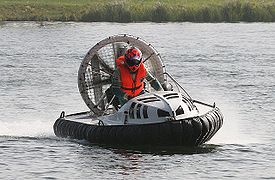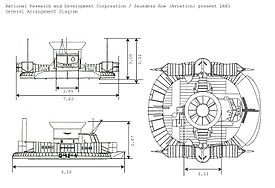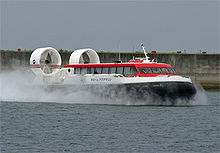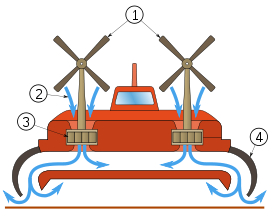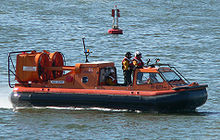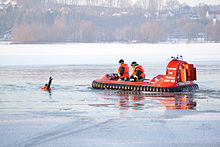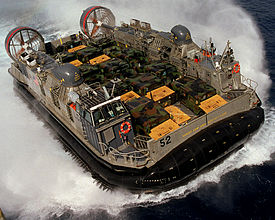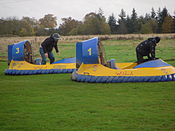
Hovercraft
About this schools Wikipedia selection
SOS Children produced this website for schools as well as this video website about Africa. SOS Children is the world's largest charity giving orphaned and abandoned children the chance of family life.
A hovercraft, also known as an air-cushion vehicle or ACV, is a craft capable of travelling over land, water, mud or ice and other surfaces both at speed and when stationary. Hovercraft are hybrid vessels operated by a pilot as an aircraft rather than a captain as a marine vessel.
They operate by creating a cushion of high-pressure air between the hull of the vessel and the surface below. Typically this cushion is contained within a flexible "skirt". They typically hover at heights between 200 mm (7.9 in) and 600 mm (24 in) above any surface and operate above 20 knots (23 mph) and can clear gradients up to 20 degrees.
The first practical design for hovercraft derived from a British invention in the 1950s to 1960s. They are now used throughout the world as specialised transports in disaster relief, coastguard, military and survey applications as well as for sport or passenger service. Very large versions have been used to transport hundreds of people and vehicles across the English Channel whilst others have military applications used to transport tanks, soldiers and large equipment in hostile environments and terrain.
History
Early efforts
There have been many attempts to understand the principles of high air pressure below hulls and wings. To a great extent, the majority of these can be termed "ground effect" or "water effect" vehicles rather than hovercraft. The principal difference is that a hovercraft can lift itself while still, whereas the majority of other designs require forward motion to create lift. These active-motion "surface effect vehicles" are known in specific cases as ekranoplan and hydrofoils.
The first mention in the historical record of the concepts behind surface-effect vehicles that used the term hovering was by Swedish scientist Emanuel Swedenborg in 1716.
In 1915, Austrian Dagobert Müller (1880 - 1956) built the world's first "water effect" vehicle. Shaped like a section of a large aerofoil (this creates a low pressure area above the wing much like an aircraft), the craft was propelled by four aero engines driving two submerged marine propellers, with a fifth engine that blew air under the front of the craft to increase the air pressure under it. Only when in motion could the craft trap air under the front, increasing lift. The vessel also required a depth of water to operate and could not transition to land or other surfaces. Designed as a fast torpedo boat, the Versuchsgleitboot had a top speed over 32 knots (59 km/h). It was thoroughly tested and even armed with torpedoes and machine guns for operation in the Adriatic. It never saw actual combat, however, and as the war progressed it was eventually scrapped due to lack of interest and perceived need, and its engines returned to the Air Force.
The theoretical grounds for motion over an air layer were constructed by Konstantin Eduardovich Tsiolkovskii in 1926 and 1927.
In 1931, Finnish aero engineer Toivo J. Kaario began designing a developed version of a vessel using an air cushion and built a prototype Pintaliitäjä (Surface Soarer), in 1937. Kaario's design included the modern features of a lift engine blowing air into a flexible envelope for lift. Kaario never received funding to build his design, however. Kaario's efforts were followed closely in the Soviet Union by Vladimir Levkov, who returned to the solid-sided design of the Versuchsgleitboot. Levkov designed and built a number of similar craft during the 1930s, and his L-5 fast-attack boat reached 70 kn (130 km/h) in testing. However, the start of World War II put an end to Levkov's development work.
During World War II, an engineer in the United States of America, Charles Fletcher, invented a walled air cushion vehicle. Because the project was classified by the U.S. government, Fletcher could not file a patent.
Post-war progress
When the war ended a number of groups took up development of low friction water vessels including hydrofoil and water effects. The Soviets, specifically Rostislav Alexeyev and his Central Hydrofoil Design Bureau, returned to the ground effect design pioneered by Levkov, and produced a wide variety of such craft over the next 30 years. However, Alexeyev's systems were always experimental, and never entered production. Famous among these is the Lun-class ekranoplan, a massive missile-firing boat powered by eight jet engines. Unlike Levkov's design, however, these boats generally lacked a lift engine, using power and short wings to create lift at speed. This represented a unique evolution of craft but were also not classed as true hovercraft.
In the 1950s and 1960s in Canada, John Carver Meadows Frost at Avro Canada started experimenting with the Coandă effect and noticed that he could produce a ring of airflow by blowing the air down over a convex surface. He originally intended this to produce VTOL lift, and then use the same basic effect to provide for high-speed, high-altitude flight. This work led to the development of the Avrocar with the US Army, a design of much more modest performance more typical of a modern helicopter. In testing it proved incapable of flying more than a few feet off the ground and at speeds greater than about 45 km/h, and after a lengthy period of testing the program was abandoned in 1961.
Christopher Cockerell
The idea of the modern hovercraft is most often associated with Sir Christopher Cockerell. Cockerell came across the key concept in his design when studying the ring of airflow when high-pressure air was blown into the annular area between two concentric tin cans, one coffee and the other from cat food. This produced a ring of airflow, as expected, but he noticed an unexpected benefit as well; the sheet of fast moving air presented a sort of physical barrier to the air on either side of it. This effect, which he called the "momentum curtain", could be used to trap high-pressure air in the area inside the curtain, providing lift based on pressure, not airflow. In theory, only a small amount of active airflow would be needed to create lift and much less than a design that relied only on the momentum of the air to provide lift, like a helicopter. In terms of power, a hovercraft would only need between one quarter to half of the power required by a helicopter.
Cockerell built several models of his hovercraft design in the early 1950s, featuring an engine mounted to blow from the front of the craft into a space below it, combining both lift and propulsion. He demonstrated the model flying over many Whitehall carpets in front of various government experts and ministers, and the design was subsequently put on the secret list. In spite of tireless efforts to arrange funding no branch of the military was interested, as he later noted, "The Navy said it was a plane not a boat; the Air Force said it was a boat not a plane; and the Army was 'plain not interested.'"
SR.N1
This lack of military interest meant that there was no reason to keep the concept secret, and it was declassified. Cockerell was finally able to convince the National Research Development Corporation to fund development of a full-scale model. In 1958 the NRDC placed a contract with Saunders Roe for the development of what would become the SR.N1, short for "Saunders Roe, Nautical 1". The SR.N1 was powered by a 450 hp Alvis Leonides engine powering a vertical fan in the middle of the craft. In addition to providing the lift air, a portion of the airflow was bled off into two channels on either side of the craft, which could be directed to provide thrust. In normal operation this extra airflow was directed rearward for forward thrust, and blew over two large vertical rudders that provided directional control.
SR.N1 made its first hover on 11 June 1959, and made its famed successful crossing of the English Channel on 25 July 1959. In December 1959, the Duke of Edinburgh visited Saunders Roe at East Cowes and persuaded the chief test-pilot, Commander Peter Lamb, to allow him to take over the SR.N1's controls. He flew SR.N1 so fast that he was asked to slow down a little. On examination of the craft afterwards, it was found that she had been dished in the bow due to excessive speed, damage which was never allowed to be repaired, and was from then on affectionately referred to as the 'Royal Dent'.
Skirts and other improvements
Testing quickly demonstrated that the idea of using a single engine to provide air for both the lift curtain and forward flight required too many trade-offs. A Blackburn Marboré for forward thrust and two large vertical rudders for directional control were added, producing the SR.N1 Mk II. A further upgrade with the Armstrong Siddeley Viper produced the Mk III. Further modifications, especially the addition of pointed nose and stern areas, produced the Mk IV.
Although the SR.N1 was successful as a testbed, the design hovered too close to the surface to be practical; at 23 cm even small waves would hit the bow. The solution was offered by Cecil Latimer-Needham. In 1958 he suggested the use of two rings of rubber to produce a double-walled extension of the vents in the lower fuselage. When air was blown into the space between the sheets it exited the bottom of the skirt in the same way it formerly exited the bottom of the fuselage, re-creating the same momentum curtain, but this time at some distance from the bottom of the craft.
Latimer-Needham and Cockerell devised a 4 foot (1.22 m) high skirt design which was fitted to the SR.N1 to produce the Mk V, displaying hugely improved performance, with the ability to climb over obstacles almost as high as the skirt. In October 1961, Latimer-Needham sold his skirt patents to Westland, who had recently taken over Saunders Roe's interest in the hovercraft. Experiments with the skirt design demonstrated a problem; it was originally expected that pressure applied to the outside of the skirt would bend it inward, and the now-displaced airflow would cause it to pop back out. What actually happened is that the slight narrowing of the distance between the walls resulted in less airflow, which in turn led to more air loss under that section of the skirt. The fuselage above this area would drop due to the loss of lift at that point, and this led to further pressure on the skirt.
After considerable experimentation, Denys Bliss at Hovercraft Development Ltd. found the solution to this problem. Instead of using two separate rubber sheets to form the skirt, a single sheet of rubber was bent into a U shape to provide both sides, with slots cut into the bottom of the U forming the annular vent. When deforming pressure was applied to the outside of this design, air pressure in the rest of the skirt forced the inner wall to move in as well, keeping the channel open. Although there was some deformation of the curtain, the airflow within the skirt was maintained and the lift remained relatively steady. Over time, this design evolved into individual extensions over the bottom of the slots in the skirt, known as "fingers".
Commercialisation
With these improvements the hovercraft became an effective transport system for high-speed service on water and shallow land, leading to widespread developments for military vehicles, search and rescue, and commercial operations. By 1962 many UK aviation and ship building firms were working on hovercraft designs, including Saunders Roe/Westland, Vickers-Armstrong, William Denny, Britten-Norman and Folland. Small-scale ferry service started as early as 1962 with the launch of the Vickers-Armstrong VA-3. With the introduction of the 254 passenger and 30 car carrying SR.N4 cross-Channel ferry in 1968, hovercraft had developed into useful commercial craft.
Another major pioneering effort of the early hovercraft era was carried out by Jean Bertin's firm in France. Bertin was an advocate of the "multi-skirt" approach, which used a number of smaller cylindrical skirts instead of one large one in order to avoid the problems noted above. During the early 1960s he developed a series of prototype designs, which he called "terraplanes" if they were aimed for land use, and "naviplanes" for water. The best known of these designs was the N500 Naviplane, built for Seaspeed by SEDAM. The N500 could carry 400 passengers, 55 cars and 5 buses. It set a speed record between Boulogne to Dover of 74 knots (137 km/h). It was rejected by its operators who claimed it was unreliable.
Another discovery was that the total amount of air needed to lift the craft was a function of the roughness of the surface it traveled over. On flat surfaces, like pavement, the needed air pressure was so low that hovercraft were able to compete in energy terms with conventional systems like steel wheels. However, as the hovercraft lift system acted as both a lift and very effective suspension, it naturally lent itself to high-speed use where conventional suspension systems were considered too complex. This led to a variety of "hovertrain" proposals during the 1960s, including England's Tracked Hovercraft and France's Aérotrain. In the U.S., Rohr Inc. and Garrett both took out licenses to develop local versions of the Aérotrain. These designs competed with maglev systems in the high-speed arena, where their primary advantage was the very "low tech" tracks they needed. On the downside, the air blowing out from under the trains presented a unique problem in stations, and interest in them waned in the 1970s.
By the early 1970s the basic concept had been well developed, and the hovercraft had found a number of niche roles where its combination of features were advantageous. Today they are found primarily in military use for amphibious operations, search and rescue vehicles in shallow water, and sporting vehicles.
Design
Hovercraft can be powered by one or more engines. Small craft, such as the SR.N6, usually have one engine with the drive split through a gearbox. On vehicles with several engines, one usually drives the fan (or impeller), which is responsible for lifting the vehicle by forcing high pressure air under the craft. The air inflates the "skirt" under the vehicle, causing it to rise above the surface. Additional engines provide thrust in order to propel the craft. Some hovercraft use ducting to allow one engine to perform both tasks by directing some of the air to the skirt, the rest of the air passing out of the back to push the craft forward.
Uses
Commercial
The British aircraft manufacturer Saunders-Roe developed the first practical man-carrying hovercraft, the SR.N1, which carried out several test programmes in 1959 to 1961 (the first public demonstration in 1959), including a cross-channel test run in July 1959 piloted by Peter ("Sheepy") Lamb, an ex-naval test pilot and the Chief Test Pilot at Saunders Roe. Christopher Cockerell was on board, and the flight took place on the 50th anniversary of Louis Blériot's first aerial crossing.
The SR.N1 was powered by one (piston) engine, driven by expelled air. Demonstrated at the Farnborough Airshow in 1960, it was shown that this simple craft could carry a load of up to 12 Marines with their equipment as well as the pilot and co-pilot with only a slight reduction in hover height proportional to the load carried. The SR.N1 did not have any skirt, using instead the peripheral air principle that Sir Christopher had patented. It was later found that the craft's hover height was improved by the addition of a skirt of flexible fabric or rubber around the hovering surface to contain the air. The skirt was an independent invention made by a Royal Navy officer, C.H. Latimer-Needham, who sold his idea to Westland (parent company of Saunders-Roe), and who worked with Sir Christopher to develop the idea further.
The first passenger-carrying hovercraft to enter service was the Vickers VA-3, which in the summer of 1962 carried passengers regularly along the north Wales Coast from Moreton, Merseyside, to Rhyl. It was powered by two turboprop aero-engines and driven by propellers.
During the 1960s Saunders-Roe developed several larger designs which could carry passengers, including the SR.N2, which operated across the Solent in 1962 and later the SR.N6, which operated across the Solent from Southsea to Ryde on the Isle of Wight for many years. In 1963 the SR.N2 was used on an experimental service between Weston-super-Mare and Penarth under the aegis of P & A Campbell, the paddle steamer operators.
Operations by Hovertravel commenced on July 24, 1965 using the SR.N6 which carried just 38 passengers. Two 98 seat AP1-88 hovercraft were introduced on this route in 1983, and in 2007 these were joined by the first 130 seater BHT130 craft. The AP1-88 and the BHT130 were notable as they were largely built by Hoverwork using shipbuilding techniques/materials (i.e. welded aluminium structure and diesel engines) rather than the aircraft techniques used to build the earlier craft built by Saunders-Roe/ British Hovercraft Corporation. Over 20 million passengers had used the service as of 2004 – the service is still operating (2010) and is by far the longest, continuously operated hovercraft service.
In 1966, two cross-channel passenger hovercraft services were inaugurated using SR.N6 hovercraft. Hoverlloyd ran services from Ramsgate Harbour, England, to Calais, France, and Townsend Ferries also started a service to Calais from Dover, which was soon superseded by that of Seaspeed.
As well as Saunders-Roe and Vickers (which combined in 1966 to form the British Hovercraft Corporation (BHC)), other commercial craft were developed during the 1960s in the UK by Cushioncraft (part of the Britten-Norman Group) and Hovermarine based at Woolston (the latter being 'Sidewall Hovercraft', where the sides of the hull projected down into the water to trap the cushion of air with 'normal' hovercraft skirts at the bow and stern). One of these models, the HM-2, was used by Red Funnel between Southampton (near the Woolston Floating Bridge) and Cowes.
The world's first car-carrying hovercraft was made in 1968, the BHC Mountbatten class (SR.N4) models, each powered by four Rolls-Royce Proteus gas turbine engines. These were both used by rival operators Hoverlloyd and Seaspeed to operate regular car and passenger carrying services across the English Channel. Hoverlloyd operated from Ramsgate, where a special hoverport had been built at Pegwell Bay, to Calais. Seaspeed operated from Dover, England, to Calais and Boulogne in France. The first SR.N4 had a capacity of 254 passengers and 30 cars, and a top speed of 83 kn (154 km/h). The Channel crossing took around 30 minutes and was run rather like an airline with flight numbers. The later SR.N4 Mk.III had a capacity of 418 passengers and 60 cars to the Isle of Wight . These were later joined by the French-built SEDAM N500 Naviplane with a capacity of 385 passengers and 45 cars; only one entered service and was used intermittently for a few years on the cross-channel service until returned to SNCF in 1983. The service ceased in 2000 after 32 years, due to competition with traditional ferries, catamaran, the disappearance of duty-free shopping within the EU and the advancing age of the SR.N4 hovercraft and the opening of the Channel Tunnel.
The commercial success of hovercraft suffered from rapid rises in fuel prices during the late 1960s and 1970s, following conflict in the Middle East. Alternative over-water vehicles such as wave-piercing catamarans (marketed as the SeaCat in the UK until 2005) use less fuel and can perform most of the hovercraft's marine tasks. Although developed elsewhere in the world for both civil and military purposes, except for the Solent Ryde to Southsea crossing, hovercraft disappeared from the coastline of Britain until a range of Griffon Hovercraft were bought by the Royal National Lifeboat Institution.
Civilian non-commercial
In Finland, small hovercraft are widely used in maritime rescue and during the rasputitsa ("mud season") as archipelago liaison vehicles. In England, hovercraft of the Burnham-on-Sea Area Rescue Boat (BARB) are used to rescue people from thick mud in Bridgwater Bay. Avon Fire and Rescue Service became the first Local Authority fire service in the UK to operate a hovercraft. It is used to rescue people from thick mud in the Weston-super-Mare area and during times of inland flooding. A Griffon rescue Hovercraft has been in use for a number of years with the Airport Fire Service at Dundee Airport in Scotland. It is used in the event of an aircraft ditching in the Tay estuary. Numerous fire departments around the U.S./Canadian Great Lakes operate hovercraft for water and ice rescues, often of ice fisherman stranded when ice breaks off from shore.
In October 2008 The Red Cross commenced a flood-rescue service hovercraft based in Inverness, Scotland. Gloucestershire Fire and Rescue Service received two flood-rescue hovercraft donated by Severn Trent Water following the 2007 UK floods.
Since 2006 hovercraft have been used in aid in Madagascar by HoverAid, an international NGO who use the hovercraft to reach the most remote places on the island. The Scandinavian airline SAS used to charter an AP1-88 hovercraft for regular passengers between Copenhagen Airport, Denmark, and the SAS Hovercraft Terminal in Malmö, Sweden.
In 1998, the US Postal Service began using the British built Hoverwork AP1-88 to haul mail, freight, and passengers from Bethel, Alaska, to and from eight small villages along the Kuskokwim River. Bethel is far removed from the Alaska road system, thus making the hovercraft an attractive alternative to the air based delivery methods used prior to introduction of the hovercraft service. Hovercraft service is suspended for several weeks each year while the river is beginning to freeze to minimize damage to the river ice surface. The hovercraft is able to operate during the freeze-up period; however, this could potentially break the ice and create hazards for villagers using their snowmobiles along the river during the early winter.
In 2006 Kvichak Marine Industries of Seattle USA built, under license, a cargo/passenger version of the Hoverwork BHT130. Designated 'Suna-X', it is used as a high speed ferry for up to 47 passengers and 47,500 pounds of freight serving the remote Alaskan villages of King Cove and Cold Bay.
An experimental service was operated in Scotland across the Firth of Forth (between Kirkcaldy and Portobello, Edinburgh), from 16 to 28 July 2007. Marketed as Forthfast, the service used a craft chartered from Hovertravel and achieved an 85% passenger load factor. As of 2009 the possibility of establishing a permanent service is still under consideration.
Since the channel routes abandoned hovercraft, and pending any reintroduction on the Scottish route, the United Kingdom's only public hovercraft service is that operated by Hovertravel between Southsea (Portsmouth) and Ryde on the Isle of Wight.
From the 1960s, several commercial lines were operated in Japan, without much success. In Japan the last commercial line had linked Ōita Airport and central Ōita but was shut down in October 2009.
Hovercraft are still manufactured in the UK near to where they were first conceived and tested and the Isle Of Wight. They can also be chartered for a wide variety of uses including inspections of shallow bed offshore wind farms and VIP or passenger use. A typical vessel would be a Tiger IV or a Griffon. They are light, fast, road transportable and very adaptable with the unique feature of minimising damage to environments.
Military
First applications of the hovercraft in military use was with the SR.N1 through SR.N6 craft built by Saunders-Roe in the Isle of Wight in the UK and used by the UK joint forces. To test the use of the hovercraft in military applications the UK set up the Interservice Hovercraft Trials Unit (IHTU) base at Lee-on-the-Solent (now the site of the Hovercraft Museum). This unit carried out trials on the SR.N1 from Mk1 through Mk5 as well as testing the SR.N2, SR.N3, SR.N5 and SR.N6 craft. Currently the Royal Marines use the Griffonhoverwork 2400TD hovercraft, the replacement for the Griffon 2000 TDX Class ACV as a tactical craft. The 2000 was deployed by the UK in Iraq.
In the US, during the 1960s, Bell licenced and sold the Saunders-Roe SR.N5 as the Bell SK-5. They were deployed on trial to the Vietnam War by the United States Navy as PACV patrol craft in the Mekong Delta where their mobility and speed was unique. This was used in both the UK SR.N5 curved deck configuration and later with modified flat deck, gun turret and grenade launcher designated the 9255 PACV. The United States Army also experimented with the use of SR.N5 hovercraft in Vietnam. Three hovercraft with the flat deck configuration were deployed to Dong Tam in the Mekong delta region and later to Ben Luc. They saw action primarily in the Plain of Reeds. One was destroyed in early 1970 and another in August of that same year after which the unit was disbanded. The only remaining U.S. Army SR.N5 hovercraft is currently on display in the Army Transport Museum in Virginia. Experience led to the proposed Bell SK-10 which was the basis for the LCAC-class air-cushioned landing craft now deployed by the U.S. and Japanese Navy.
The Soviet Union was the world's largest developer of military hovercraft. Their designs range from the small Czilim class ACV, comparable to the SR.N6, to the monstrous Zubr class LCAC, the world's largest hovercraft. The Soviet Union was also one of the first nations to use a hovercraft, the Bora, as a guided missile corvette, though this craft possessed rigid, non-inflatable sides. With the fall of the Soviet Union most Soviet military hovercraft fell into disuse and disrepair. Only recently has the modern Russian Navy begun building new classes of military hovercraft.
The Finnish Navy designed an experimental missile attack hovercraft class, Tuuli class hovercraft, in the late 1990s. The prototype of the class, Tuuli, was commissioned in 2000. It proved an extremely successful design for a littoral fast attack craft, but due to fiscal reasons and doctrinal change in the Navy, the hovercraft was soon withdrawn.
The Hellenic Navy operates four Russian-designed Zubr class LCAC. This is the world’s largest military air-cushioned landing craft.
The People's Army Navy of China operates the Jingsah II class LCAC. This troop and equipment carrying hovercraft is roughly the Chinese equivalent of the U.S. Navy LCAC.
Recreational/sport
Small commercially manufactured, kit or plan-built hovercraft are increasingly being used for recreational purposes such as inland racing and cruising on inland lakes and rivers, marshy areas, estuaries and inshore coastal waters.
The Hovercraft Cruising Club is dedicated to encouraging, supporting and developing the safe & considerate operation of recreational cruising hovercraft. It organises training, informal hover-events, and offers world-class hovercraft design tools, advice on safe operation, member discounts and craft insurance. It has an active and informative club member forum.
The Hovercraft Club of Great Britain, founded in 1966, regularly organizes inland and coastal hovercraft race events at various venues across the United Kingdom.
In August 2010 the Hovercraft Club of Great Britain hosted the World Hovercraft Championships at Towcester Racecourse The World Hovercraft Championships are run under the auspices of the World Hovercraft Federation. Similar events are also held in Europe and the US.
Other
Hoverbarge
A real benefit of air cushion vehicles in moving heavy loads over difficult terrain, such as swamps, was overlooked by the excitement of the British Government funding to develop high-speed hovercraft. It was not until the early 1970s that the technology was used for moving a modular marine barge with a dragline on board for use over soft reclaimed land.
Mackace (Mackley Air Cushion Equipment), now known as Hovertrans, produced a number of successful Hoverbarges, such as the 250 ton payload “Sea Pearl” which operated in Abu Dhabi and the twin 160 ton payload "Yukon Princesses" which ferried trucks across the Yukon river to aid the pipeline build. Hoverbarges are still in operation today. In 2006, Hovertrans (formed by the original managers of Mackace) launched a 330 ton payload drilling barge in the swamps of Suriname.
The Hoverbarge technology is somewhat different from high-speed hovercraft, which has traditionally been constructed using aircraft technology. The initial concept of the air cushion barge has always been to provide a low-tech amphibious solution for accessing construction sites using typical equipment found in this area, such as diesel engines, ventilating fans, winches and marine equipment. The load to move a 200 ton payload ACV barge at 5 kn (9.3 km/h) would only be 5 tons. The skirt and air distribution design on the high-speed craft again is more complex as they have to cope with the air cushion being washed out by a wave and wave impact. The slow speed and large mono chamber of the hover barge actually helps reduce the effect of wave action giving a very smooth ride.
The low pull force enabled a helicopter to pull a hoverbarge across snow, ice and water in 1982.
Hovertrains
Several attempts have been made to adopt air cushion technology for use in fixed track systems, in order to utilize the lower frictional forces for delivering high speeds. The most advanced example of this was the Aérotrain, an experimental high speed hovertrain built and operated in France between 1965 and 1977. The project was abandoned in 1977 due to lack of funding, the death of its lead engineer and the adoption of TGV by the French government as its high-speed ground transport solution.
A test track for a tracked hovercraft system was built at Earith near Cambridge, England. It ran southwest from Sutton Gault, sandwiched between the Old Bedford River and the smaller Counter Drain to the west. Careful examination of the site will still reveal traces of the concrete piers used to support the structure. The actual vehicle, RTV31, is preserved at Railworld in Peterborough and can be seen from trains, just south west of Peterborough railway station. The vehicle achieved 104 mph (167 km/h) on 7 February 1973 but the project was cancelled a week later. The project was managed by Tracked Hovercraft Ltd., with Denys Bliss as Director in the early 1970s, only to be axed by the Aerospace Minister, Michael Heseltine. Records of this project are available from the correspondence and papers of Sir Harry Legge-Bourke, MP at Leeds University Library. Heseltine was accused by Airey Neave and others of misleading the House of Commons when he stated that the government was still considering giving financial support to the Hovertrain, when the decision to pull the plug had already been taken by the Cabinet.
Despite promising early results, the Cambridge project was abandoned in 1973 due to financial constraints, but parts of the project were picked up by the engineering firm Alfred McAlpine, only to be finally abandoned in the mid-1980s. The Tracked Hovercraft project and Professor Laithwaite's Maglev train system were contemporaneous, and there was intense competition between the two prospective British systems for funding and credibility.
At the other end of the speed spectrum, the Dorfbahn Serfaus has been in continuous operation since 1985. This is an unusual underground air cushion funicular rapid transit system, situated in the Austrian ski resort of Serfaus. Only 1,280 m (4,200 ft) long, the line reaches a maximum speed of 25 mph (40 km/h). A similar system also exists in Narita International Airport near Tokyo, Japan.
In the late 1960s and early 1970s the U.S. Department of Transport's Urban Mass Transit Administration funded several hovertrain projects which were known as Tracked Air Cushion Vehicles or TACVs. They were also known as Aerotrains since one of the builders had a licence from Bertin's Aerotrain company. Three separate projects were funded. Research and development was carried out by Rohr, Inc., Garrett AiResearch and Grumman. The UMTA built an extensive test site in Pueblo, Colorado, with different types of tracks for the different technologies used by the prototype contractors. They managed to build prototypes and do a few test runs before the funding was cut.
Non-transportation
The Hoover Constellation was a spherical canister-type vacuum cleaner notable for its lack of wheels. Floating on a cushion of air, it was a domestic hovercraft. They were not especially good as vacuum cleaners as the air escaping from under the cushion blew uncollected dust in all directions, nor as hovercraft as their lack of a skirt meant that they only hovered effectively over a smooth surface. Despite this, original Constellations are sought-after collectibles today.
The Flymo is an air-cushion lawn mower which uses a fan on the cutter blade to provide lift. This allows it to be moved in any direction, and provides double-duty as a mulcher.
The Marylebone Cricket Club owns a 'hover cover' that it uses regularly to cover the pitch at Lord's Cricket Ground. This device is easy and quick to move, and has no pressure points, making damage to the pitch less likely. The system is quite popular at major pitches in the UK.
Preservation
Lee-on-the-Solent, Hampshire, England, is the home to the Hovercraft Museum which houses the world's largest collection of hovercraft designs, including some of the earliest and largest. Much of the collection is housed within two retired SR.N4 hovercraft, and many hovercraft in the collection are operational.
Hovercraft are still in use between Ryde on the Isle of Wight and Southsea on the mainland. The service, operated by Hovertravel, runs many times an hour and is the fastest way of getting on or off the island. Large passenger hovercraft are still manufactured on the Isle of Wight.
Records
- World's Largest Civil Hovercraft - The BHC SR.N4 Mk.III, at 56.4 m (185 ft) length and 310 metric tons (305 long tons) weight, can accommodate 418 passengers and 60 cars.
- World's largest military hovercraft - The Russian Zubr class LCAC at 57.6 meters length and a maximum displacement of 535 tons. This hovercraft can transport three T-80 main battle tanks (MBT), 140 fully equipped troops, or up to 130 tons of cargo. Four have been purchased by the Greek Navy.
- English Channel crossing - 22 minutes by Princess Anne MCH SR.N4 Mk.III on September 14, 1995
- World's Hovercraft Speed Record - September 18, 1995 - Speed Trials, Bob Windt (USA) 137.4 km/h (85.87 mph), 34.06 secs measured kilometre
- Longest continuous use - The original prototype SR.N6 Mk.I (009) was in service for over twenty years, and logged a remarkable 22,000 hours of use. It is currently on display at the Hovercraft Museum in Lee-on-the-Solent, Hampshire, England.

